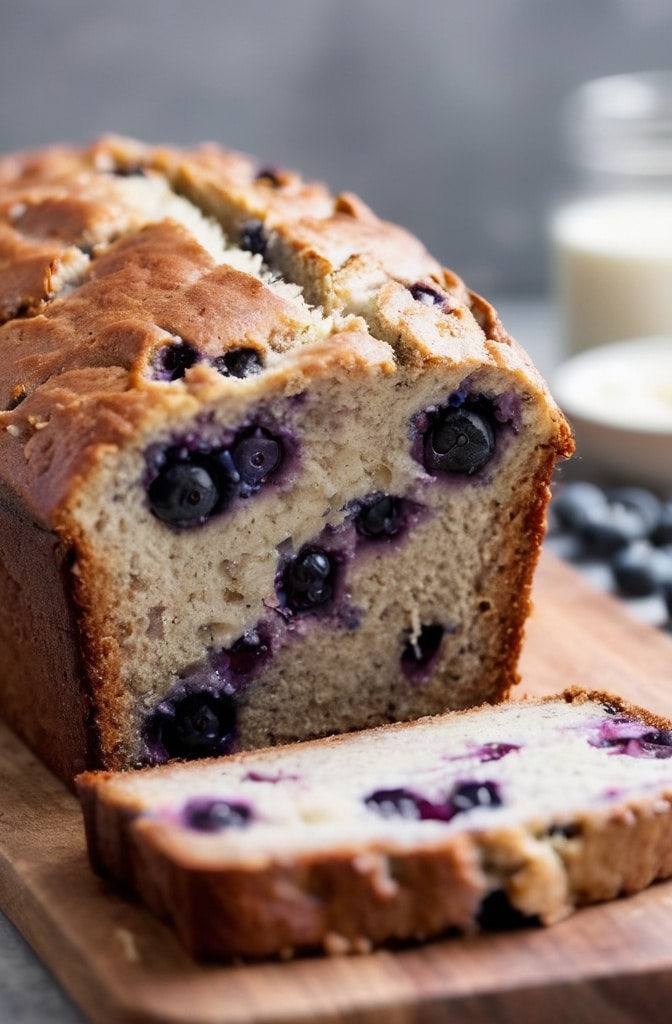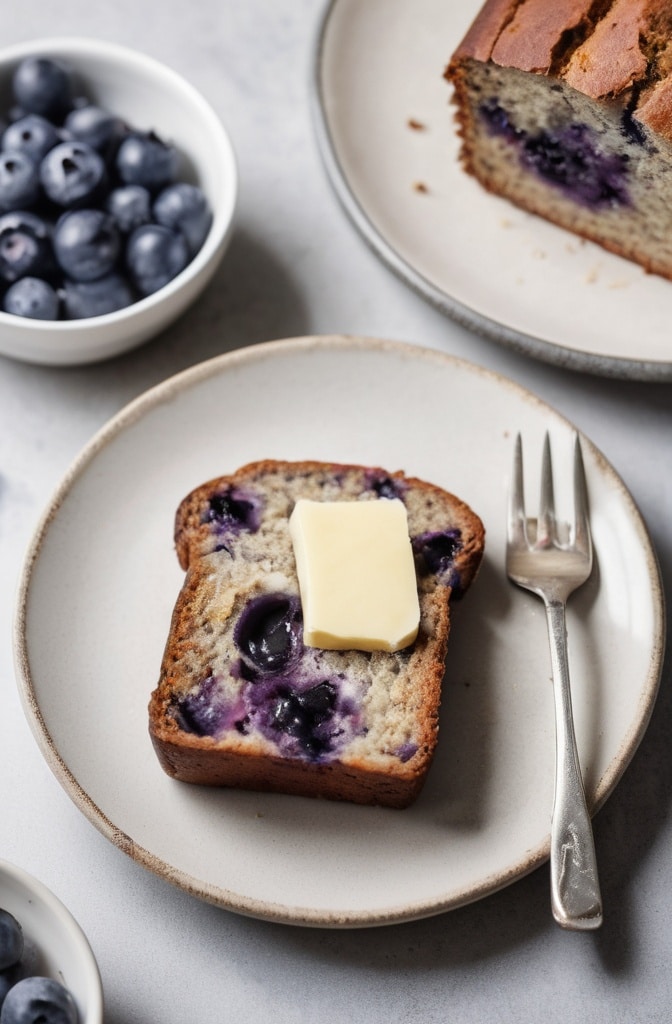There’s something magical about the aroma of Fresh Blueberry Banana Bread wafting through your kitchen. Now imagine that familiar comfort elevated with bursts of juicy blueberries nature’s little antioxidant powerhouses. I’ve spent countless mornings perfecting this recipe in my test kitchen, and the marriage of sweet, caramelized bananas with tart blueberries creates what I believe is the perfect breakfast quick bread. This isn’t just another banana bread recipe; it’s an entirely new experience in the form of Fresh Blueberry Banana Bread.
The beauty of this particular version lies in its perfect balance. Too many banana breads are cloyingly sweet or disappointingly dry. Not this one. We’re creating a moisture-rich loaf with a tender crumb that showcases both fruits without letting either dominate. The blueberries provide pockets of jammy goodness that complement the banana’s natural sweetness in ways that’ll make you wonder why this isn’t already a classic combination.
Ingredients & Substitutions
For the Bread:
- 2 cups (240g) all-purpose flour
- 1 teaspoon baking soda
- ½ teaspoon fine sea salt
- ½ teaspoon ground cinnamon
- ½ cup (113g) unsalted butter, softened
- ¾ cup (150g) granulated sugar
- 2 large eggs, room temperature
- 1½ cups mashed overripe bananas (about 3-4 medium)
- 2 tablespoons plain yogurt or sour cream
- 1 teaspoon vanilla extract
- 1½ cups fresh blueberries (or 1¼ cups frozen, unthawed)
For the Optional Streusel Topping:
- ⅓ cup (40g) all-purpose flour
- ¼ cup (50g) light brown sugar, packed
- ½ teaspoon ground cinnamon
- 3 tablespoons cold unsalted butter, cubed
- Pinch of salt
Selecting the right bananas is absolutely crucial for this recipe. You want them properly overripe—we’re talking deep brown spots covering at least 50% of the peel. These bananas contain more sugar and aromatic compounds that contribute to that distinct banana bread flavor we all crave. Underripe bananas simply won’t disolve properly into the batter, leaving you with a less flavorful bread.
For the blueberries, fresh is preferable when in season, but frozen works wonderfully in winter months. If using frozen, do not thaw them beforehand—this prevents the juices from bleeding throughout the batter. Wild blueberries offer more intense flavor in a smaller package, while cultivated berries provide bigger pops of juice. Both are delicious, just different experiences.
The addition of yogurt or sour cream might seem minor, but its tangy acidity activates the baking soda while adding extra moisture. If dairy-free, unsweetened coconut yogurt makes an excellent substitution that adds a subtle tropical note that pairs beautifully with the bananas.
Step-by-Step Instructions

Preparation:
- Preheat your oven to 350°F (175°C). Line a 9×5-inch loaf pan with parchment paper, leaving overhang on the long sides for easy removal. This is much better than just greasing the pan, as it prevents any potential sticking.
- In a medium bowl, whisk together flour, baking soda, salt, and cinnamon until well combined. The cinnamon is technically optional, but it enhances the banana flavor without overwhelming it—a professional trick many bakeries employ.
- Toss your blueberries with 1 tablespoon of the flour mixture and set aside. This coating prevents them from sinking to the bottom during baking, ensuring even distribution throughout your loaf.
Making the Batter:
- In a stand mixer fitted with the paddle attachment (or using a hand mixer), cream together the butter and sugar on medium-high speed until light and fluffy, about 3-4 minutes. Don’t rush this step—proper creaming incorporates air that gives your bread its proper texture.
- Add eggs one at a time, beating well after each addition until fully incorporated. The mixture may look slightly curdled; that’s perfectly normal.
- Add the mashed bananas, yogurt, and vanilla, mixing on low just until combined. Overmixing at this stage can develop too much gluten, leading to a tougher bread.
- Gradually add the flour mixture, mixing on low speed just until no dry streaks remain. The batter should be thick but pourable. I sometimes leave a few small streaks of flour visible, as they’ll disappear during folding.
- Using a rubber spatula, gently fold in the flour-coated blueberries by hand. This careful touch prevents the berries from breaking and turning your batter purple. A few gentle folds is all it takes.
Optional Streusel (if using):
- In a small bowl, combine flour, brown sugar, cinnamon, and salt. Work the cold butter cubes into this mixture using your fingertips until it resembles coarse crumbs. This should take about 2-3 minutes of rubbing the butter into the dry ingredients.
- Refrigerate the streusel while you finish preparing the batter. Cold streusel creates those desirable crisp, buttery pockets on top of your bread.
Baking:
- Pour the batter into your prepared loaf pan, smoothing the top with your spatula. If using streusel, sprinkle it evenly over the surface.
- Bake in the preheated oven for 55-65 minutes, or until a toothpick inserted into the center comes out with just a few moist crumbs (not wet batter). Starting to check at the 50-minute mark is wise, as ovens can vary significanly.
- Cool in the pan for 15 minutes before using the parchment paper overhang to lift the bread out. Transfer to a wire rack to cool completely before slicing. This resting period allows the structure to set and flavors to meld.
Cooking Techniques & Science
The secret to exceptional banana bread lies in understanding the chemistry at play. Bananas contain enzymes that break down starches into sugars as they ripen, which is why those spotted, overripe bananas deliver such incredible flavor and natural sweetness. These enzymes also help tenderize the crumb, creating that melt-in-your-mouth texture banana bread is known for.

Incorporating blueberries introduces an interesting technical challenge. Their high water content can potentially make surrounding areas of the bread gummy if not properly managed. The flour coating we apply creates a barrier that absorbs some of this moisture during baking, preventing soggy patches. Additionally, their natural acidity reacts with the baking soda, providing extra lift to counteract their weight in the batter.
The order of operations matters tremendously in quick breads. Creaming the butter and sugar creates microscopic air pockets that expand during baking. These air pockets give the bread its proper structure. Adding eggs one at a time ensures each is fully emulsified into the fat before introducing the next, creating a stable base for your wet ingredients.
Temperature control also plays a vital role. Room temperature ingredients blend more uniformly, preventing the batter from “breaking” or separating. The butter needs to be soft enough to cream but not melted, ideally between 65-67°F. Cold butter won’t incorporate enough air; melted butter won’t trap any. This precise attention to temperature makes the difference between good and exceptional banana bread.
Variations & Creative Twists
Chocolate Lover’s Version:
Fold in ¾ cup semi-sweet chocolate chips along with the blueberries. The slight bitterness of good chocolate creates a sophisticated counterpoint to the sweet fruit notes. For true decadence, use chopped dark chocolate instead of chips—the irregular pieces create pockets of melted chocolate throughout.
Nutty Enhancement:
Add ½ cup toasted walnuts or pecans for textural contrast. Toasting nuts before adding them amplifies their flavor by releasing essential oils. A quick 8-minute toast in a 350°F oven makes all the difference.
Spiced Sophistication:
Enhance the spice profile by adding ¼ teaspoon each of nutmeg and cardamom to the dry ingredients. These warming spices complement both fruits beautifully and add complexity without overwhelming. The cardamom especially brings out the blueberries’ natural perfume.
Lemon Brightness:
Add 1 tablespoon of fresh lemon zest to the batter. The citrus oils in the zest cut through the richness and enhance the blueberry flavor. You could also replace the vanilla extract with lemon extract for an even more pronounced citrus note.
Serving & Pairing Suggestions
Serve this blueberry banana bread slightly warm or at room temperature. If serving warm, a quick 10-second reheat in the microwave revitalizes the bread’s aroma and softness. A thin slice of European-style cultured butter pairs wonderfully with the fruity notes, its tanginess complementing the sweet-tart profile.
For breakfast, consider serving alongside Greek yogurt drizzled with honey. The creamy yogurt balances the bread’s natural sweetness and adds protein for a more complete meal. A light dusting of powdered sugar just before serving adds visual appeal for special occasions or brunch presentations.
Coffee pairings should lean toward medium roasts with fruit or nut undertones. The acidity of lighter roasts complements the blueberries, while the caramel notes in medium roasts enhance the banana. Tea drinkers should opt for Earl Grey or a fruit-forward herbal blend.
When serving as dessert, transform it into a rustic bread pudding by cubing day-old slices and soaking in a vanilla custard before baking. Top with a warm blueberry compote for an elevated dessert that honors the bread’s origins while creating something entirely new.
Storage & Freshness Tips

This bread reaches its flavor peak on day two when the ingredients have had time to fully meld. Store at room temperature, tightly wrapped in plastic or in an airtight container, for up to 3 days. The moisture from the bananas and blueberries helps it stay remarkably fresh.
For longer storage, freeze slices individually wrapped in plastic and then placed in a freezer bag. This method allows you to thaw only what you need. Individual slices thaw in about 30 minutes at room temperature or can be toasted from frozen for a warm treat with crispy edges.
Resist the urge to refrigerate this bread—the cold temperature accelerates starch retrogradation, making the bread seem stale more quickly. If you must refrigerate (perhaps during very hot weather), always bring slices back to room temperature before serving, or better yet, lightly toast them.
Final Thoughts: Why This Recipe Works
What makes this particular recipe successful is its thoughtful balance. The moisture from the bananas prevents the crumb from drying out, while the flour coating on the blueberries ensures they remain suspended in the batter rather than sinking. The touch of yogurt adds tenderness and activates the leavening agents for proper rise.
Professional bakers know that quick breads improve with a rest before slicing. This 24-hour waiting period allows the gluten to relax and flavors to develop fully. If you can resist cutting into it immediately (and I understand if you can’t!), you’ll be rewarded with even better flavor the next day.
Remember that baking is both science and art. The science ensures your bread rises properly and bakes evenly, but the art comes in recognizing when the bananas are at their peak ripeness or how gently to fold those berries without crushing them. Master both aspects, and this blueberry banana bread will become your signature recipe—the one friends and family request by name.
FAQs About Fresh Blueberry Banana Bread Recipe
Can I use frozen bananas for this recipe?
Absolutely! Frozen bananas work wonderfully. Thaw them completely in their peels, then drain off excess liquid before mashing. The freezing process actually breaks down cell walls, making the bananas even sweeter and easier to incorporate into your batter.
Why did my blueberries sink to the bottom of the bread?
This typically happens when blueberries aren’t coated with flour or when the batter is too thin. Ensure you’re tossing the berries in flour as directed, and check that your banana mash isn’t overly liquidy. If using particularly juicy bananas, you might need an extra tablespoon or two of flour in the batter.
Can I make this recipe gluten-free?
Yes, with modifications. Replace the all-purpose flour with a high-quality 1:1 gluten-free baking blend that contains xanthan gum. The structure will be slightly different, but still delicious. Add an extra egg for binding power and reduce the baking time by about 5 minutes, checking doneness early.
How ripe should my bananas really be?
The ideal banana for baking should have a peel that’s about 40-50% brown spotted. The flesh inside should be soft but not completely mushy or fermented-smelling. If your bananas aren’t ripe enough, you can quickly ripen them by placing them in a paper bag with an apple overnight, or bake them in their peels at 300°F for 15-20 minutes until blackened.
Why did my bread crack on top?
That beautiful crack down the center isn’t a flaw—it’s actually a sign of success! It occurs when the exterior sets while the interior continues to rise. This creates that characteristic “quick bread split” that professional bakers recognize as proper development. The crack provides an attractive rustic appearance and is completely normal.

